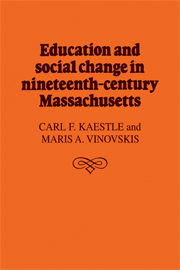Book contents
- Frontmatter
- Contents
- List of tables and figures
- Preface
- 1 Education and social change: Massachusetts as a case study
- 2 Trends in school attendance in nineteenth-century Massachusetts
- 3 From apron strings to ABCs: school entry in nineteenth-century Massachusetts
- 4 The prospects of youth: school leaving in eight Essex County towns
- 5 From one room to one system: the importance of rural–urban differences in nineteenth-century Massachusetts schooling
- 6 Education and social change in two nineteenth-century Massachusetts communities
- 7 Trends in educational funding and expenditures
- 8 The politics of educational reform in mid-nineteenth-century Massachusetts
- 9 Conclusion: the triumph of a state school system
- Appendix A Statistical tables
- Appendix B Definition of the variables contained in Tables A2.1 through A2.5, Appendix A
- Appendix C Discussion of adjustments, estimates, and extrapolations made in calculating Tables A2.1 through A2.5, Appendix A
- Notes
- Bibliography
- Index
Preface
Published online by Cambridge University Press: 05 October 2010
- Frontmatter
- Contents
- List of tables and figures
- Preface
- 1 Education and social change: Massachusetts as a case study
- 2 Trends in school attendance in nineteenth-century Massachusetts
- 3 From apron strings to ABCs: school entry in nineteenth-century Massachusetts
- 4 The prospects of youth: school leaving in eight Essex County towns
- 5 From one room to one system: the importance of rural–urban differences in nineteenth-century Massachusetts schooling
- 6 Education and social change in two nineteenth-century Massachusetts communities
- 7 Trends in educational funding and expenditures
- 8 The politics of educational reform in mid-nineteenth-century Massachusetts
- 9 Conclusion: the triumph of a state school system
- Appendix A Statistical tables
- Appendix B Definition of the variables contained in Tables A2.1 through A2.5, Appendix A
- Appendix C Discussion of adjustments, estimates, and extrapolations made in calculating Tables A2.1 through A2.5, Appendix A
- Notes
- Bibliography
- Index
Summary
The laudatory tradition of educational history that prevailed in the United States until the 1950s emphasized democracy, opportunity, humanitarianism, enlightenment, and the development of an American consensus as motives for public schooling. Historians of education, often committed to the schools of their day by virtue of their positions as school administrators or education professors, saw public schools as the engines of American democracy, as the bulwark of free institutions, and as the “balance wheel of the social machinery,” in Horace Mann's famous phrase. This tradition emphasized the relationship of schooling to the political system and to the development of a common American culture. It was an idealist tradition, which was, and still is, widely shared by the American public.
The past fifteen years, however, have seen a pendulum swing among some historians on questions about the initial and continuing purposes of public schooling. A new critical view has emerged, emphasizing socioeconomic realities rather than political ideals. Revisionist historians have emphasized class and cultural conflict, bureaucracy, and the schools' role in inculcating submissive attitudes. Their work constitutes a reaction against the old history of education, and also against the consensus view of American history of the 1950s. Although their normative perspective is often much more negative, the revisionists share a basic assumption of their predecessors: They assume that the structure and content of public schooling have been largely determined by the political and economic system in America.
- Type
- Chapter
- Information
- Education and Social Change in Nineteenth-Century Massachusetts , pp. xvii - xxiiPublisher: Cambridge University PressPrint publication year: 1980

